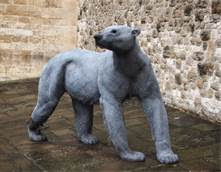 Man has always had a fascination with exotic animals.
Of course we have made our way along with our domesticated dog or cat, “man’s
best friends”, but exotics are another thing. We can come close to them, but a
danger always exists. We might assume they can be friendly, but the fact
remains that we really don’t know. They are mysterious, and that’s their
appeal.
Man has always had a fascination with exotic animals.
Of course we have made our way along with our domesticated dog or cat, “man’s
best friends”, but exotics are another thing. We can come close to them, but a
danger always exists. We might assume they can be friendly, but the fact
remains that we really don’t know. They are mysterious, and that’s their
appeal.
And so, people like to “collect” them if they can. Often
times, they can only be obtained, or purchased and maintained, if one has
tremendous means….Like Kings! Herein lies the idea of the Royal Menagerie!
 Though there is one in Versailles in France, I am
familiar with the one in London! The actual animals don’t exist there anymore,
but they once lived and amused the English kings. Actually, in the 12th
Century, during the reign of King John, a group of exotic beasts arrived by
three ships from Europe and Africa. In a sense, his collection
became one of Britian’s oldest zoos. Some say the menagerie began with King Henry III’s
gift of a white bear from the King of Norway. Supposedly the king had a chain
put on its leg so it could fish in the Thames River, but not escape. In Elizabethan times, the collection grew and
became a popular tourist attraction. These animals were housed somewhere in the
Tower of London’s walled grounds, though the actual location is not known.
Though there is one in Versailles in France, I am
familiar with the one in London! The actual animals don’t exist there anymore,
but they once lived and amused the English kings. Actually, in the 12th
Century, during the reign of King John, a group of exotic beasts arrived by
three ships from Europe and Africa. In a sense, his collection
became one of Britian’s oldest zoos. Some say the menagerie began with King Henry III’s
gift of a white bear from the King of Norway. Supposedly the king had a chain
put on its leg so it could fish in the Thames River, but not escape. In Elizabethan times, the collection grew and
became a popular tourist attraction. These animals were housed somewhere in the
Tower of London’s walled grounds, though the actual location is not known.  By 1704, the Menagerie included six lions, two
leopards or tigers, three eagles, two Swedish owls, two “cats of the
mountains”, and a jackal. The guidebook, published in 1741 listed the lions as
Marco and Phillis; Jenny and Nancy (lionesses); leopard called Will, a panther
called Jenny. The book also mentions a porcupine, ape, raccoon and a strange
bird from the East Indies called a warwoven.
By 1704, the Menagerie included six lions, two
leopards or tigers, three eagles, two Swedish owls, two “cats of the
mountains”, and a jackal. The guidebook, published in 1741 listed the lions as
Marco and Phillis; Jenny and Nancy (lionesses); leopard called Will, a panther
called Jenny. The book also mentions a porcupine, ape, raccoon and a strange
bird from the East Indies called a warwoven.  During the 18th Century, the Dey of Tunis
sent two ostriches to the King, and to their detriment, it was thought they
liked to eat iron. They were fed nails, and soon died. The popularity of the Menagerie declined
towards the end of the 18th Century, with poor care of the animals
and unsanitary conditions. We have come a long way where preserves and zoos are
at issue.
During the 18th Century, the Dey of Tunis
sent two ostriches to the King, and to their detriment, it was thought they
liked to eat iron. They were fed nails, and soon died. The popularity of the Menagerie declined
towards the end of the 18th Century, with poor care of the animals
and unsanitary conditions. We have come a long way where preserves and zoos are
at issue.
Lions were prized as living symbols of royalty for
England. The big cats in the Tower were an impressive sight, but upon their
death, they were just dumped on the site. Recently two skulls were discovered by
archeologists, carbon dated to the 12th Century. The other sometime
from the 1400’s. A leopard’s skull, though quite damaged, was also found, thought
from the Tudor reign.
Currently,
there is an incredibly beautiful display of some of the royal beasts at The
Tower. They are sculptural pieces so very real, though made of metal mesh, that
you feel they might spring or pounce at any minute. I love them. The artist who
created them is Kendra Haste. One area
has the lions, another, an elephant, and finally a grouping of monkeys that are
located, perhaps guarding, near the jewelry gift shop. And so, with these
marvelous sculptures, we can honor the original Menagerie of magnificent
beasts.































